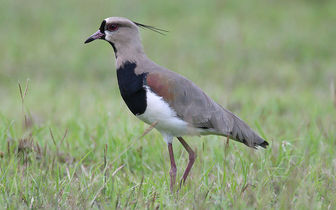Southern Lapwing
Belonopterus chilensis Dorypaltus prosphatus Brodkorb, 1959 Parra chilensis Molina, 1782 and see text

Original source: Own work
Author: Mdf
Permission: GNU Free Documentation License
The Southern Lapwing is classified as Least Concern. Does not qualify for a more at risk category. Widespread and abundant taxa are included in this category.
* Southern Lapwing, Vanellus chilensis * Grey-headed Lapwing, Vanellus cinereus * Crowned Lapwing, Vanellus coronatus * Long-toed Lapwing, Vanellus crassirostris * River Lapwing or Spur-winged Lapwing, Vanellus duvaucelii * Red-wattled Lapwing, Vanellus indicus * Masked Lapwing, Vanellus miles * Spur-winged Lapwing or Spur-winged Plover, Vanellus spinosus * Banded Lapwing, Vanellus tricolor More
The Southern Lapwing (Vanellus chilensis) is a wader in the family Charadriiformes. It is a common and widespread resident throughout South America, except in densely forested regions (e.g. most of the Amazon), the higher parts of the Andes and the arid coast of a large part of western South America. This bird is particularly common in the basin of the River Plate. It has also been spreading through Central America in recent years. More
The Southern Lapwing ranges throughout South America except on the Pacific coast from Peru northwards and in parts of Amazonia. It is found in open areas near water and marshes and is frequently seen near habitation and on farmland. Some farmers use them as guards as they are very aggressive and give out a loud call when disturbed. In places such as Brazil this loud call gives rise to local names such as "Quero-quero". More
The Southern Lapwing easily can be recognized. It is a large plover, common both to rural and urban areas. The filamentous crest, black face and broad black patch, its alarm call, very aggressive mobbing behavior, and wing spurs make it a well-known species. The lack of a similar species within the distribution of the Southern Lapwing makes these characteristics very reliable ways of identifying this species. More
The Southern Lapwing is a conspicuous inhabitant of grasslands and pastures from Panama and northern South America south to Tierra del Fuego. A large, crested lapwing, the Southern Lapwing has gray brown upperparts with a bronze sheen, a black breast band that extends up to the bird’s forehead, wing spurs, and a white belly and undertail coverts. Southern Lapwings feed mainly on insects, as well as small fish and aquatic invertebrates. More
Southern Lapwing (Vanellus chilensis) Southern Lapwing (Vanellus chilensis) on eggs Southern Lapwing (Vanellus chilensis) on eggsThe Southern Lapwing (Vanellus chilensis) is a wader in the family Charadriiformes. It is the national bird of Uruguay, where it is called tero. Due to its bold and pugnacious nature it has become the namesake and mascot of the Uruguay national rugby union team, Los Teros. In Brazil it is widely known as quero-quero, an onomatopoetic of its commonly heard voice. More
southern lapwing in flight.jpg (50400 bytes) Chagaramas southern lapwing sitting.jpg (191909 bytes) Ste. Madeline website page counter References Birds of Venezuela. Steven L. Hilty. 2003, Christopher Helm, London A Guide to the Birds of Trinidad and Tobago. 2nd edition, Richard ffrench. 1992, Helm, London Jeffrey R. Walters, 1990. Anti-Predatory Behavior of Lapwings: Field Evidence of Discriminative Abilities. Wilson Bulletin, Vol. More
The Southern Lapwing (Vanellus chilensis) is a species of wading bird that is a common resident throughout South America, except in dense forested regions, higher altitudes of the Andes, and the arid coast of western South America. It is fairly common in the River Plate basin and has been spreading through Central America in recent years. Its habitat is lake and river banks or open grassland. It has benefited from widespread cattle ranching. More
XC17218 :: Southern Lapwing (Vanellus chilensis lampronotus) = Recording data Recordist Nick Athanas Date 09-04-2005 Time 09:15 Country Brazil Location Reserva Ecologica de Guapiassu - RJ Longitude W42.43'36" Latitude S22. More
The Southern Lapwing Vanellus chilensis (formerly Belonopterus cayennensis lampronotus) is a large wader. It is a common and widespread resident throughout Central and South America, except in the jungles of the Amazon and the Andes. This bird is particularly common in the basin of the River Plate. It is the national bird of Uruguay. More

Original source: Arthur Chapman
Author: Arthur Chapman
Permission: Some rights reserved
Family : Charadriidae
Genus : Vanellus
Species : chilensis
Authority : (Molina, 1782)
